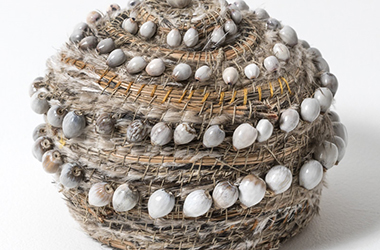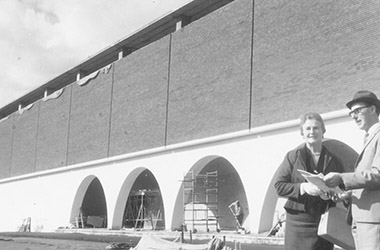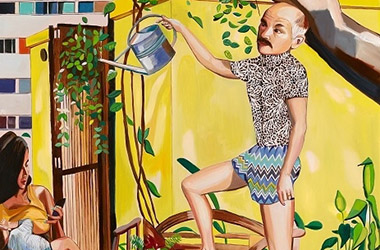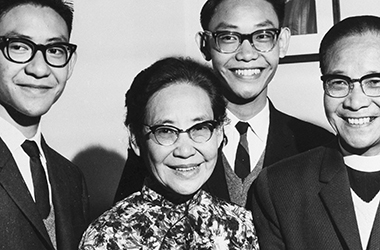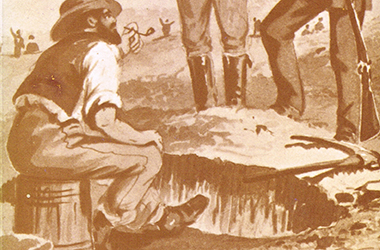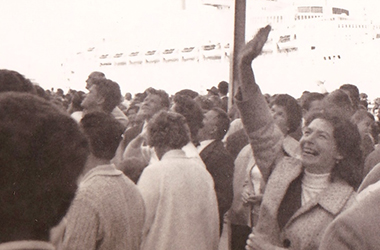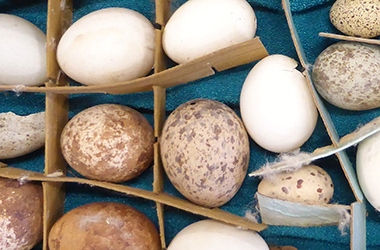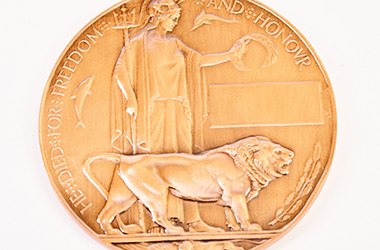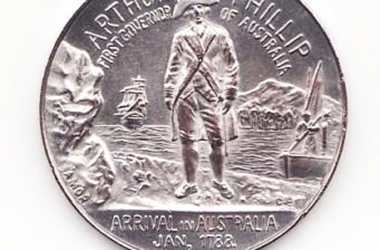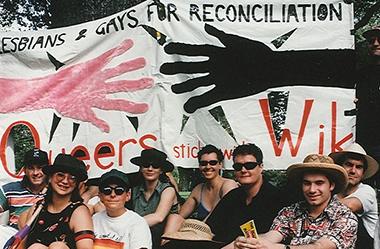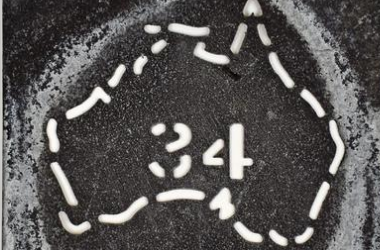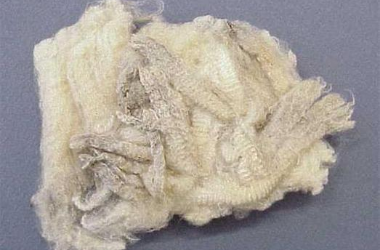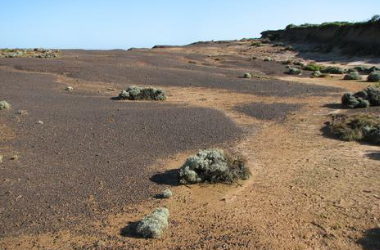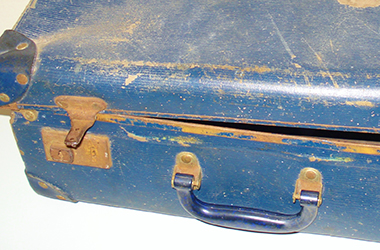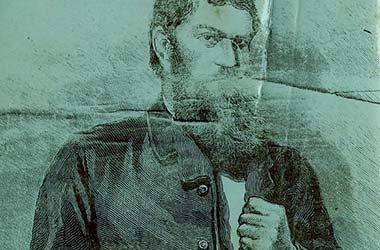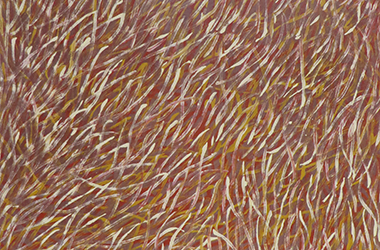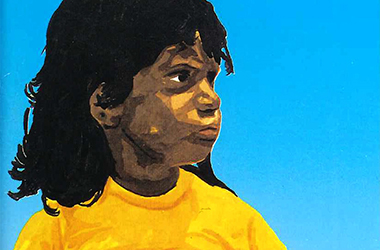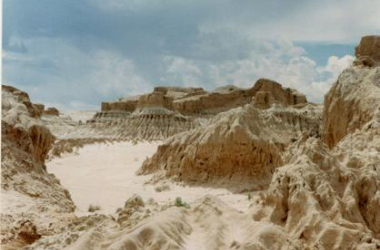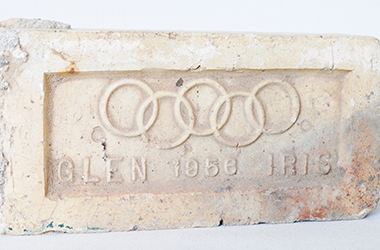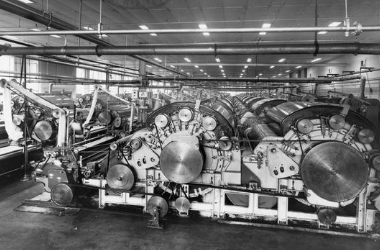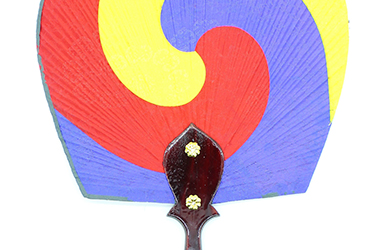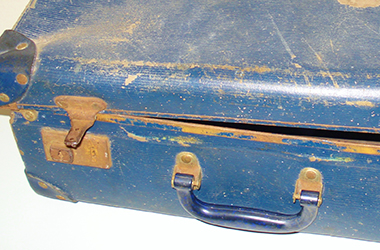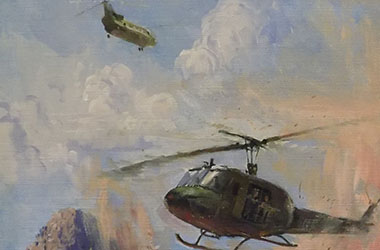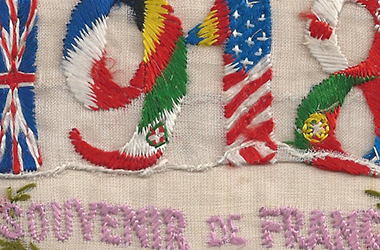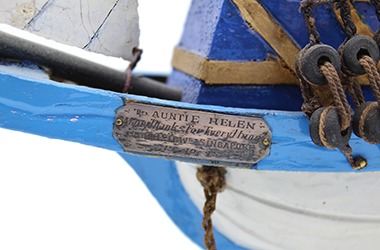Browse stories
-

Theatrical Families
Born in a Trunk and Living in a Suitcase
Whether bonded by blood or shared experience, family strongly underpins the foundations of the performing arts industry. "I was born in a trunk" is a familiar introductory phrase used by those born of theatrical parents.
This story tells of the great Australian theatrical managements of J.C. Williamson Ltd (The Firm), and the Tivoli Circuit.
It also provides insights into Australian theatrical families such as: Tony Sheldon, his mother Toni Lamond, father Frank Sheldon, grandparents Max Reddy and Stella Lamond, and aunt Helen Reddy; and Val Jellay and her husband Maurie Fields, who met and married while touring together in the travelling company Sorlie's.
In the theatrical industry people like Irene Mitchell, artistic director of the Little Theatre which became St Martin's Youth Arts Centre, Gertrude Johnson, artistic director of the National Theatre, and Betty Pounder, choreographer and casting agent for J.C. Williamson, provided role models and mentoring for a generation of Melbourne actors and performers.
The text above has been abstracted from an essay Born in a trunk and living out of a suitcase written by Carolyn Laffan for the publication The Australian Family: Images and Essays. The full text of the essay is available as part of this story.
The Performing Arts Museum (now known as The Arts Centre, Melbourne, Performing Arts Collection) produced the exhibition Kindred Spirits - The Performing Arts Family as part of The Australian Familyproject, which involved 20 Victorian museums and galleries. The full series of essays and images are available in The Australian Family: Images and Essays published by Scribe Publications, Melbourne 1998, edited by Anna Epstein. The book comprises specially commissioned and carefully researched essays with accompanying artworks and illustrations from each participating institution.
-

TV50 Anniversary of Television in Australia
Television broadcasting arrived in Australia in 1956. At the end of that year only about 5% of Melbourne households had a television set. That figure is now closer to 99%.
Fifty years have seen many much-loved shows and celebrities come and go. The technologies of production have changed. Our televisions are no longer the bulky furniture items that once dominated the lounge room.
In 2006 the Australian Centre for the Moving Image (ACMI) celebrated the 50th anniversary of Australian TV with an exhibition dedicated to its rich heritage.
TV50 brought together iconic objects from the ACMI collection, the television networks and memorabilia accrued in private collections.
Many significant objects were acquired by ACMI from Mr Bob Phillips, whose career as a floor manager/producer - and collecting passion - began in the still pioneering days of the early sixties.
-

What’s Going On!
What’s Going On! was a groundbreaking exhibition presenting contemporary indigenous artists from the Murray Darling basin.
Taking Mildura as the centre, at the confluence of the Murray and Darling Rivers, the exhibition ranges from Menindee, Wilcannia and Broken Hill to the north and north east, Berri in the south west and Swan Hill to the east, dissolving State boundaries that fragment this distinct region. Uniting the artists in the exhibition are extended family networks and connections to country.
There is a much-loved story told by Aboriginal people on the Murray, that when you open out the swim bladder of a Murray cod, the tree-like forms of its skin reveal the place where the fish was born. Aboriginal children are sometimes told that this is the very same tree under which they were born. These various skin stories reveal the connection of people to the Murray Darling river system, where ‘everyone has a place under the tree’.
-

Contemporary Artists Honour Barak
During the 1860s, at the time of the NGV’s founding, William Barak (1863–1903) was a Wurundjeri leader and artist of great renown, working for his people at Coranderrk, near Healesville. In honour of the NGV’s 150th anniversary, the Felton Bequest commissioned three contemporary artists to create installations that honour Barak’s art and life.
Vernon Ah Kee’s Ideas of Barak, consists of three parts in different media. Jonathan Jones’s untitled (muyan) is an installation of five light boxes that pulse with LED geometric designs. Brook Andrew’s Marks and witness is a dizzying wall drawing of Wiradjuri designs of zigzag and diamond that reference Barak’s possum skin cloak designs.
These works are on display in the multimedia room of the Indigenous Galleries, above the escalator and in the stairwell of The Ian Potter Centre: NGV Australia at Federation Square.
In this story, Vernon Ah Kee and Jonathan Jones talk about their creative process and Auntie Joy Murphy-Wandin talks about Barak, and the artists’ engagement with him, and about Barak’s work at Coranderrk.
CULTURAL WARNING: Aboriginal and Torres Strait Islander users of this website are warned that this story contains images of deceased persons and places that could cause sorrow.
-
 Megan Cardamone
Megan CardamoneGanagan
I dreamt about weaving a net. So I did just that. I wove a net! When I started weaving my net my mind wandered back in time and I thought about how it must have been for my ancestors who lived along the mighty Murray River.
GLENDA NICHOLLS Waddi Waddi/Yorta Yorta/Ngarrinjeri
Glenda Nicholls entered her Ochre Net into the Victorian Indigenous Art Awards in 2012 and was the winner of the Koorie Heritage Trust Acquisition Award.
When Glenda’s Ochre Net came into the Trust’s care, it inspired this exhibition of artworks and stories relating to waterways and their significance to Koorie people. Powerful spiritual connections to waterways, lakes and the sea are central to Koorie life and culture.
The works shown in Ganagan Deep Water come from the Trust’s collections and represent many Koorie cultural groups from south-eastern Australia.
The Ganagan Deep Water exhibition at the Koorie Heritage Trust was sponsored by Melbourne Water.
This online component of the Ganagan exhibition is sponsored by the Maritime Museums of Australia Project Support Scheme, supported by the Australian Government through the Australian National Maritime Museum.
Ganagan means ‘deep water’ in the Taungurung language.
CULTURAL WARNING: Aboriginal and Torres Strait Islander users of this website are warned that this story contains images of deceased persons and places that could cause sorrow.
-

Indigenous Stories about Family
Family is central to our lives: from our immediate families to our neighbourhoods and communities.
Explore the present and our history, from a celebration of culture to a reflection on hard times, such as the stolen generations, share our stories about family and what family means to us.
There are stories about indigenous families in different Victorian communities, the memories of Gunditjmara Elder Aunty Iris Lovett-Gardiner and her life at Lake Condah Mission. Stories of football, dance and culture and life in the Yorta Yorta community of Echuca as well as much, much more.
CULTURAL WARNING: Aboriginal and Torres Strait Islander users are warned that this material may contain images and voices of deceased persons, and images of places that could cause sorrow.
-

Post-War Europe
In 1945, Australian Prime Minister Chifley lead the Labor Party to power in Canberra and sought to change the national focus from agriculture to industry.
His government established the Department of Immigration, which soon introduced a policy of financially supporting migration to Australia. Due to the 2nd World War, large numbers of displaced people and refugees that took up this opportunity. Most came from Great Britain and Europe and on arrival were provided accommodation in hostels or transition camps in return for a commitment to provide labour on government funded projects for a period of two years.
These personal stories produced as part of the ACMI Digital Storytelling program recount the journeys of people in the Post War Immigration Scheme.
Discover the story of Australia’s involvement in the Second World War, from primary sources at the State Library of Victoria's Ergo site : - Australia & WWII
-

Recent Arrivals
The Australian Government’s policy of mandatory detention of unauthorised arrivals by boat has been the subject of intense political and national debate in recent years around the ethics of detaining people who in many cases have fled their homeland to escape conflict or oppression.
These stories produced as part of the ACMI Digital Storytelling program document the experiences of people who have recently arrived in Australia.
-

Second Generation
For many migrants, the real benefits of migration are seen in the second generation of the family, as migration has afforded life opportunities for their children that would have been unavailable to them in their homeland.
Through ACMI’s Digital Storytelling program, the children of migrants document their personal stories and share the richness and challenges of their bicultural lives in Australia.
-

1956 Flood
In 1956, a monster flood overwhelmed the banks of the Murray and Darling Rivers, producing floodwaters in surrounding towns and rural areas that reached over 30 feet above normal levels.
The Murray Darling Environmental Foundation's 1956 Flood video features historical footage - including photographs and wonderful super8 film from personal collections - that document the rise and flow of the waters, and the monumental effort mobilised to tackle them.
It is presented here in 3 extracts.
The full video is over 25 minutes long, and copies can be obtained from:
Emma Bradbury, Murray Darling Association, Post Office Box 1268, Echuca 3564
Email: [email protected]
-

Land and Spirit
Land and Spirit are inseparable, providing the foundation of all that sustains us.
The videos include excerpts from "Lady of the Lake"- Gunditjmara Elder Aunty Iris Lovett-Gardiner's accounts of Lake Condah Mission and Indigenous experiences there and excerpts from the film "Wominjeka (Welcome)", "Baranjuk" about Uncle Wally Cooper a Yorta Yorta Elder and Colin Walker senior.
Further material can be found at the State Library of Victoria's Ergo site: Native Title and the Yorta Yorta claim
CULTURAL WARNING: Aboriginal and Torres Strait Islander users are warned that this material may contain images of deceased persons and images of places that could cause sorrow.
-

Our Story
Welcome to Country! Learn about Koorie Culture: our people, our flags, and history.
CULTURAL WARNING: Aboriginal and Torres Strait Islander users are warned that this material may contain images and voices of deceased persons, and images of places that could cause sorrow.
-

Working and Learning
Stories about our working lives, education, and looking to the future.
The videos include excerpts from "Lady of the Lake"- Gunditjmara Elder Aunty Iris Lovett-Gardiner's accounts of Lake Condah Mission and Indigenous experiences there and excerpts from the film "Baranjuk" about Uncle Wally Cooper a Yorta Yorta Elder.
CULTURAL WARNING: Aboriginal and Torres Strait Islander users are warned that this material may contain images and voices of deceased persons, and images of places that could cause sorrow.
-

Illuminated by Fire
These short films, created for the Illuminated By Fire project by Malcolm McKinnon, tell a range of stories about living in some of the most fire-prone places on the planet.
They reveal a wealth of knowledge, experience and imagination in our response to fire.
The Illuminated By Fire project is about the places we care about and the story and role of fire within those places.
-

Football Stories from Country Victoria
Country Football. On one hand it's just a game. On the other, it's life or death...
Films in this collection are a record of living memory: how the game has changed; how it continues to evolve; and how football is inextricably linked with our communities.
These 21 films include stories of legendary games, long time campaigners, rivalries, reluctant mergers, and of things lost and lamented. Collected from all corners of Victoria.
-

Mallee Sporting Heroes
Phil Crump, motorcycle speedway legend; Rachael Sporn, Olympic basketballer; Chris Brown, football stalwart; Dot Jenkinson, legendary lawn-bowler; Deserie Wakefield-Baynes, Olympic clay-target shooter; and Ron Gregg, acclaimed cricketer: they all hail from the Mallee, in Victoria's far North-west.
These delightful films let us in on their lives, their sporting histories, and the places which shaped them.
-

Mapping Great Change
This series of films and stories is centred on a beautiful and complex map with the ungainly name: Plan of the General Survey from the Town of Malmsbury to the Porcupine Inn, from the sources of Forest Creek to Golden Point, shewing the Alexandrian Range, also Sawpit Gully, Bendigo and Bullock Creeks.
In many ways, the map is a mirror of our times: the map is a record of the 'critical years' between 1835 and 1852 in which the dispossession of Aboriginal people of Victoria was allowed to occur; we contemporary people are in the "critical decade" for making the changes necessary to avoid catastrophic climate change.
If we fail to act effectively in this decade, it will be as loaded with moral and practical consequences for coming generations as the moral and policy failures of our colonial ancestors was for the Traditional Owners of the land.
-
 Judy Scurfield
Judy ScurfieldJourney's End
Try to imagine yourself on board a sailing ship in the 19th century...
Approaching the entrance to Port Phillip Bay, which is known to be a particularly dangerous harbour entrance, being very narrow (only 2 and a half kilometers across), fringed with rocky reefs, and turbulent because of the tides meeting the ocean swells of Bass Strait.
If you were the Captain you needed an accurate chart showing sea-depths, the coastline and its hazards, but also the navigational aids such as lighthouses and beacons which would guide you into port. You would also have needed a book of sailing directions...
Judy Scurfield, librarian at the State Library of Victoria, asks us to imagine the entry through the most hazardous Port Phillip Heads.
Further material can be found at the State Library of Victoria's Ergo site: Thomas Pierson (Diaries of an early arrival chronicle first impressions of Melbourne).
-

Language, A Key to Survival: Cantonese-English Phrasebooks in Australia
Most international travellers today are familiar with phrasebooks. These books provide a guide to pronunciation, useful vocabulary, but most importantly lists of useful phrases to help travellers negotiate their way around a country where they don't speak the language.
Anyone who has tried to communicate across the language divide without such a tool knows how valuable they are.
This web story explores how Chinese from the gold rush period onwards have used phrasebooks to help them find their way in Australia. You can compare examples of Cantonese-English phrasebooks from different eras; watch Museum volunteers Nick and David speak English using a gold-rush era phrasebook; learn a little about the lives of some of the people who owned these phrasebooks; and hear Mr Ng and Mr Leong discuss their experiences learning English in Australia and China in the early to mid-twentieth century.
This project is supported through funding from the Australian Government's Your Community Heritage Program.
-

New Arrivals and Diaspora
From Colonial Settlers in the 1800s, to recent arrivals; from expatriate artists to artists that grapple with identity, politics and place: these works from the National Gallery of Victoria explore one of the great themes of Australian Art, revolving around the migrant experience, distance, identity, race and nationhood.
-

Savoy Ladies Group
The Italian community of Myrtleford, in the picturesque Ovens Valley in alpine North Eastern Victoria, arrived mainly to work in the tobacco industry which once thrived in the area. The region now has a distinctive Italian-Australian culture with settled second, third and fourth generation Italian families.
Tobacco farming was a lonely experience for many of the Italian women who migrated to Myrtleford. Unlike their husbands, the women stayed largely on the farms and lacked social contact outside of their immediate circle. Once their children grew up and mechanisation changed the labour requirements on the farms, women were frequently on their own.
The Myrtleford Savoy Ladies Group was founded in 1983 by nuns concerned about the social isolation of women in the area. It has been a great success, forming a network of companionship amongst women of Italian heritage to this day.
Cultural Warning: Aboriginal and Torres Strait Islander users of this website are warned that this story contains images of deceased persons and places that could cause sorrow.
-

Drought Stories
“The social impact it has is huge, but the footy club survives," says Charlie Gillingham, mixed farmer from Murrabit.
In this story the community talks about drought: its social impact, resilience, changes to farming practises, changing weather patterns and water trading.
The median annual rainfall of the Wimmera and northern plains of Victoria is 420mm. But this median does not convey the deluges that sometimes double the figure, or the dry spells that can halve it. Like semi-arid places elsewhere, the climate cycle of this region is variable.
Aboriginal people have had thousands of years to adapt to the fluctuations, whilst recent settlers are still learning.
The introduction of the Land Act of 1869 accompanied by the high rainfall La Niña years of the early 1870s brought selectors to northern Victoria and the Wimmera. A series of dry years in the 1880s initiated storage and channel projects to assist them to stay.
Irrigation was introduced in 1886 to settle the northern plains and was expanded under closer settlement legislation. The drought years from 1895 to 1902 came to be known as the Federation Drought. Water supplies dried up completely in the El Niño years of 1914 and 1915 and people took the opportunity to picnic in the empty bed of the River Murray.
Drought hit again during World War Two, and then in the period 1965-8. The drought of 1982-3 was short but devastating. Our most recent drought, lasting more than a decade, broke late in 2010 with extensive flooding.
Policy responses have changed over the years and with the recent onset of human induced climate change, continual adaptation will be required.
In 2009, the History Council of Victoria captured resident’s experiences in the project titled Drought Stories: a spoken and visual history of the current drought in Victoria. There were two aims to the project: to create a historic record of the experience, and to strengthen community capacity in rural and regional areas through telling and listening to local stories.
Two types of collections were produced: Drought Stories Local Collections, held by historical societies, and the Drought Stories Central Archive, a selection of interviews held by the State Library of Victoria.
The History Council of Victoria believes that the project material provides a rich resource to assist researchers understand Australian society at a crucial and revealing stage of adjustment to the Australian environment.
Legislation and other land records are held at the Public Record Office Victoria.
-

Melbourne Zoo and You: 150 years
In the early 1900s, a trip to Melbourne Zoological Gardens may have involved a ride on Queenie the elephant, throwing peanuts to the bears in the bear pit and watching Mollie the orang-utan smoke a cigarette in her small enclosure!
Things are different these days.
Nowadays, a visit to Melbourne Zoo could include viewing endangered Asian elephant calves, Mali and Ongard, foraging and roaming in the Trail of the Elephants habitat; viewing baby Dewi in the Orang-utan Sanctuary; listening to a keeper explain the Zoo’s breeding program for the endangered Lord Howe Island stick insect or even enjoying a twilight concert in the grounds.
The Zoo has been part of the experiences and memories of the Victorian public for 150 years, and in this story we celebrate, explore and remember the animal stars of yesterday and today, visitor experiences through the generations and stories of the keepers who have cared for the animals since it opened in 1862.
Visitor encounters and expectations of the Zoo have evolved over the years along with the Zoo’s practices. It has transformed from its early days of collecting and displaying species for public viewing to its current role in fighting extinction through local and global breeding and conservation programs.
Zoos Victoria’s commitment to fighting extinction is also explored through the Melbourne Zoo’s breeding programs for threatened and endangered species and their international conservation work outside the zoo walls.
For more on the history of Melbourne Zoo listen to Queenie, Choi and friends , a wonderful radio documentary by Hindsight, Radio National.
For further information, read:
150 years Melbourne Zoo, Zoos Victoria, Bounce Books, 2012
Almost Human: Reminiscences of Melbourne Zoo, A.A.W Wilkie, Whitcombe and Tombs, 1920
The Zoo Story, Catherine de Courcy, Penguin, 1995
Queenie’s Last Ride, Mary O’Brien, The Age, August 9, 2006
Melbourne Zoo: Acclimatisation to Conservation, Mark Kellet, Australian Heritage Magazine, 2009
Evolution of a Zoo: History of Melbourne Zoo 1857 - 1900, Catherine de Courcy, Quiddlers Press, 2003
-

Speed, Style, Spirit: The Rob Roy Hillclimb
"We have at last discovered a venue for a hillclimb par excellence. I cannot tell you about it in this issue but .... This I can promise you; that when the news is released, hillclimb enthusiasts will set to work on their cars with great zest".
The Car, October issue, 1935
In 1935, members of the Light Car Club of Australia inspected a property in Christmas Hills, some thirty kilometres north-east of Melbourne, known as Clinton's Pleasure Grounds, a picnicking venue which included the Rob Roy Shetland Pony Stud, a swimming hole, tennis courts, a cricket and football field, tea room and dance hall.
Their mission was to establish a Hillclimbing venue. Hillclimbing, a speed event in which drivers compete, one at a time, on an uphill course against the clock, is one of motorsport’s oldest events; the first was held at La Turbie near Nice, France, in 1897.
Opening on February 1, 1937, the Rob Roy Hillclimb was the first purpose-built Hillclimb in Australia. Cut out of the bush, it included an uphill half-mile, graded dirt road, a judges box and telephone boxes at the start and finish. In 1939, the track was sealed and became one of only three bitumen-surfaced purpose-built hillclimbs in the world, the other two being the Shelsley Walsh and Prescott courses in the UK.
The Rob Roy Hillclimb has a special place in Australia’s motoring history, with eight record holders going on to become Australian Grand Prix winners and one – Jack Brabham – a triple F1 World Champion. The roll call of other drivers who displayed their skills at the Rob Roy includes Harry Firth, Stan Jones, Lex Davison, Bill Patterson, Doug Whiteford, Peter Whitehead, Reg Hunt, Diana Davison Gaze, Tony Gaze and Len Lukey.
The Rob Roy Hillclimb was more than a racing event, it was a culture. Connected to Formula One racing, celebrities, champion drivers, patrons, collectors, and prestige and iconic cars, the Rob Roy had an aura of glamour, and club meets were social occasions, with drivers adhering to collar and tie dress codes and picnickers fashionably attired.
Nevertheless the cars were central. Over the years Bugattis, Jaguars, MGs, Falkenbergs, Oldses and Altas have competed with Australian makes such as Holdens, Fords and Elfins, from road cars to specialist cars. Many Australian cars started or developed their racing history at Rob Roy, including the Chamberlain, Maybach, BWA, Wyliecar, Klienig Special, the Walton JAP, and numerous other Australian Specials.
The Specials were modified and home-built cars. Hillclimbs make particular demands – lightweight cars with loads of torque are ideal – and so engines were upgraded, bodies stripped, cars were made up of the most suitable parts or whatever one had access to. The Specials were evidence of the culture of creativity and passion that surrounded the Hillclimb. Many cars, some pre-war, and modified constantly over time, have passed from driver to driver along with their history, to compete to this day.
In 1962, bushfires ravaged the Rob Roy, and it lay unused for another 30 years until the MG Car Club of Victoria secured a lease on the property and faithfully restored the track to host a bustling schedule of Hillclimb events. Since 1993, the Rob Roy Hillclimb culture – the drivers, the cars, the inventive mechanics and the enthralled daytrippers – thrives in the Christmas Hills.
Sources: Leon Sims, A history of Rob Roy Hillclimb - 1937 to 1961 - The Hill, The Drivers, The Cars. And, the MG Car Club of Victoria
-

Murray Darling Palimpsest #6
In 2006, Mildura Palimpsest became the Murray Darling Palimpsest, emphatically underscoring the identity of the region and its environmental interdependence.
The Murray Darling Palimpsest, staged in locations throughout the Murray Darling Basin, continues Palimpsest’s direct engagement with issues of environmental and social sustainability. With land and water use no longer in the background, Palimpsest is remarkable in its recognition that art affects attitudes, and reflects the engagement and connection many contemporary artists have to the environment; perhaps the most pressing issue we now face.
In 2006, Palimpsest brought together artists, scientists, environmentalists and other academics and commentators with the future of the Murray Darling Basin firmly in sight.
-

Digital Stories of the Land
Stories of the Land is a collection produced as part of the Australian Centre for the Moving Image (ACMI) digital storytelling program.
These stories explore the land as a thread that connects people to their surroundings. The personal narratives provide a way for understanding place on its own terms and often those terms can be challenging; drought bushfires and isolation for those who live on the land.
People across Victoria have shared stories as part of this ACMI collection capturing the essence of the land as a setting to their lives inextricably linked to the experiences and events that have shaped them.
-

Hubcaps to Creative Hubs
The project aims to tell the stories of Geelong’s industrial sites undergoing transformation, pointing to a new creative and maker culture that connects the past with the present.
The Returned Soldier & Sailors Woollen and Worsted Mills in Rutland Street Newtown, the Federal Woollen Mills in North Geelong and the Old Paper Mills in Fyansford are all in the process of becoming new creative spaces.
Part One explores how a once-overlooked industrial site the Returned Soldiers and Serviceman’s Mills (RS&S) has become the hub for a remarkable network of artists and creative makers...and if you listen closely, you might hear sounds of the past reverberating in the building’s walls.
Part Two tells the story of the recent reinvention of the Federal Woollen Mills into a tech and creative start-up hub which marks Geelong’s 21st century pivot from industrial decline to rising creative city.
Part Three explores the Fyansford Paper Mills’ salvage and restoration, a remarkable process of “creative conservation”, working with the buildings’ industrial patina and fine-grained details. The mill now hosts a creative community that draws uniquely from the large spaces and mazy corners, with secrets waiting to be unearthed.
Watch the trailer for a quick taste of the project or enjoy the full three part documentary to learn about the transformation of these places. You can also read about how these films were supported by community grants and the people and businesses of Geelong.
‘Hubcaps to Creative Hubs’ is a creative research project by Dr Fiona Gray from Deakin University, Dr Cristina Garduño Freeman from the Australian Centre for Architectural History and Cultural Heritage at the University of Melbourne, in collaboration with industry partners Jennifer Cromarty and Helen Kostiuk of Creative Geelong Inc. The films have been made by documentary producer Nicholas Searle.
-

Young and Jackson Hotel
The Young and Jackson Hotel, built in the 1850s, is one of Australia's most well known hotels. It was built, as the Princes Bridge Hotel, on part of an allotment originally purchased by John Batman in 1837.
Young and Jackson were both born in Dublin, and "chummed together" to New Zealand chasing the Otago gold deposits in 1861. It is not known when they came to Victoria, but they purchased the lease on the Princes Bridge Hotel in 1875.
-

Arthur Guy Memorial Painting Prize
Bendigo Art Gallery's Arthur Guy Memorial Painting Prize is the richest open painting prize in the country, attracting some of Australia’s finest contemporary artists. The inaugural exhibition was held in 2003, and is biennial.
The Prize was initiated by Mr Allen Guy C.B.E in honour of his late brother Arthur Guy, with equal assistance provided by the R.H.S. Abbott Bequest Fund.
Arthur Guy was born in Melbourne on 24 November 1914 and was educated at Camp Hill State School in Bendigo and then at Ballarat Grammar School. He enlisted in the Royal Australian Air Force in a signals unit and served in New Guinea. On 14 February 1945, aged 30, he was on a biscuit bomber mission when his plane was shot down near Lae. He is buried in the Lae War Memorial Cemetery.
-

In the Spirit of George Rose
Australian photographer William Yang and South Korean photographer Koo Bohnchang have created new images inspired by the Clunes-born photographer George Rose.
George Rose used a stereograph camera. This creates two images that are nearly the same. When you view them through the eyepiece, they become a 3D image.
George Rose went to Korea in 1904. His images of the streets of Seoul, and surrounding villages, are highly valued. They are almost the only images of street life in Seoul from the turn of the 20th century.
They capture a time when the Japanese were colonising Korea. The Japanese wear darker clothes in the images, the Koreans are in white. Notice how, in one of the images, a Korean climbs the city wall to gain access without going through the guarded gates. Some of the other images show the Japanese quarter, with their different style of housing and shops. Many of the images show the new electrical and telegraph wires, which had been installed by the Japanese.
George Rose’s guide was Japanese, and that influence can be seen in the way he describes the Koreans. Japanese people, at that time, considered Koreans to be a lesser culture than their own.
George Rose’s guide can be seen in one of the photos, dressed in western clothes, with a child, standing in front of a village.
In the exhibition, Koo Bohnchang used images he took in Clunes, and William Yang used images he took in Korea. Both artists reveal the gaze of the foreigner, they show what someone from outside the culture sees. This is similar to when Australian George Rose visited Korea in 1904, he too was an outsider, looking at another culture.
The curator Catherine Croll, worked closely with the photographers, travelling with them to Victoria and Korea. Below, you can see some of the images she took of the photographers at work. She was the modern-day equivalent of the ‘guide’.
Clunes has a strong relationship to Paju Book City near Seoul, they are both international Booktowns. This exhibition grew out of that relationship.
Their exhibition launched at Clunes Booktown on May 2, 2015, before it travelled around the world.
To learn more about Clunes booktown, visit www.clunesbooktown.com.au

